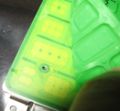Disassembly
Image:Support-banner-square.png|173px|community support pages rect 0 0 135 204 [1] rect 135 0 345 204 Support FAQ rect 0 205 135 408 [2]
- Comment : there's some whitespace here:
rect 135 205 345 408 Other support
- maybe desc none is better. testing.
desc none
</imagemap>This page describes the disassembly of the XO laptop.
- Arianne: Look at all these cautions. Shouldn't we add a "Warning: this may break your system!" label to disassembly instructions?
- Bernie: Everyone should try disassembling their XO - it was designed for this to be easy for any child. Plus, it's fun and a good learning experience. Maybe we should add a "Warranty void if this seal is NOT broken" label to encourage people to try it.
Cautions
Eye damage. There is a risk of damage to your eyes due to small pieces of metal or plastic releasing due to force stored during manufacturing or structural stress. Solution: protect your eyes.
Static discharge. There is a risk of damage to the system if you touch electronic components. You will not necessarily feel the discharge for it to do damage. The damage is not necessarily immediate, the system can fail some months later. The damage can be cumulative. Solution: ground yourself before working on your laptop.
Remove the main battery and the power cable before starting disassembly There is low risk of electric shock, since low voltages are used inside the system. However, there is a risk of accidental shorting with tools or screws. There will remain a clock battery on the main circuit board, powering a small number of circuits.
Be careful with the motherboard Avoid dropping metal objects on the motherboard. The components used are small enough that dropping a screwdriver on the board may knock off vital components.
Tools
- philips head #1 screwdriver,
If you have them:
- anti-static mat or anti-static wrist strap,
However, if you do not, touching a grounded portion of the laptop case (e.g. the screen casing or the heatsink on the motherboard) prior to handling the exposed electronics is usually sufficent to prevent any static damage. Things like extremely low humidity, or wearing synthetic fabrics may increase the risk of static discharge.
Procedure
The official disassembly section of the OLPC manual can be found at Manual/Insides. Many people find this version much easier to follow.
Remove Power
- remove the power cable,
- remove any USB or audio cables,
- remove the main battery,
Front
- set the brick (lid) at 90 degrees to the base, as if you are moving to e-book mode,
- close the antennae,
- rotate the brick 90 degrees to the left,
- examine the brick base,
- unscrew the two screws that are revealed (philips head #0),
- rotate the brick 180 degrees to the right,
- remove the other two screws revealed.
- open the antennae,
- apply upward finger force to the short green bumpers, and they should slide up and be removed,
- remove the plastic face plate over the LCD,
Back
- remove four (4) screws holding down LCD panel,
- carefully lift the bottom end of the LCD, leaving the top in place, to gain access to the two (2) screws underneath that hold on the back,
- remove the four (4) screws that hold on the back, (two covered by the LCD, two not covered by the LCD),
- if you are only changing the antennae, you can temporarily screw down the LCD with a couple of screws,
- slide the back panel down a bit before it will pop off,
Top
- the green top piece is held on by four (4) screws (or 2, depending on the model?) that are behind the back panel,
Antennae
- pull the antenna connector off the radio module, (in the absence of a proper extraction tool, a pair of pliers held lightly will do, but take care not to crush the connector),
- remove the two (2) screws holding down the antenna hinge structure, (on a B1 this structure is black plastic),
- remove the antenna and hinge structure from the system, threading the cable out through the access hole,
- remove the hinge structure and affix it to the replacement antenna, with identical orientation,
- thread the cable in through the access hole,
- screw down the hinge structure,
- push the antenna connector onto the radio module socket, (something with a flat end is useful here, the idea is to get the insertion force vertical, and leave no accidental sideways force ... it is very easy for the connector to roll sideways).
Note: before re-assembly, the antennae may seem to deviate from alignment when in the stowed position. This will change once the bumpers are put back on. The tops of the antennae meet the green bumpers in a way that brings them closer to the case.
Регистрация доменов в зоне RU по 115 рублей за год, подробности на сайте - www.rusureg.ru, icq - 575225
References
- ticket 495
- Mitch Bradley on #olpc
- Manual/Insides





































































